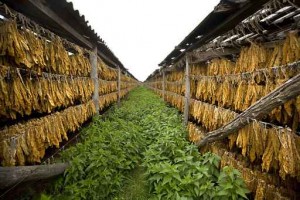 What are the secrets to growing Connecticut Shade tobacco? What makes these leaves so smooth and pleasurable? Many tobacco connoisseurs ask these questions every day. To the novice tobacco user, however, Connecticut Shade tobacco may not even be on his or her radar.
What are the secrets to growing Connecticut Shade tobacco? What makes these leaves so smooth and pleasurable? Many tobacco connoisseurs ask these questions every day. To the novice tobacco user, however, Connecticut Shade tobacco may not even be on his or her radar.
Unknowledgeable tobacco users often assume that Cuban tobacco is the best tobacco on the market. This is only partially true. Cuban tobacco makes the greatest filler, but it does not make the greatest wrapping leaf. That is where Connecticut Shade comes in.
Grown in the northern state of Connecticut, Connecticut Shade is agreed as the best wrapping leaf available. The state of Connecticut has great soil for growing tobacco.
The nutrient rich soil provides plenty of nourishment for tobacco. According to Gregory Mottola, “The Valley has been producing tobacco for more than 300 years. With its sandy soil and warm micro-climate, the land exhibits a perfect water table, providing natural drainage and good aeration—saturated soil without adequate drainage causes the plants to rot.” (1).
These conditions do not exist everywhere; in fact, Connecticut has some rare growing conditions. Mottola goes on to explain, “Because every harvest depletes the soil of necessary nutrients, growers have to replenish the fields after the harvest. Thrall uses about 4,000 pounds of organic cottonseed meal fertilizer per acre.
Phosphorus and nitrogen are a few examples of added elements required to keep the land fertile, but the ratios have to be correct to get the proper results.” (1). Ernest Gocaj, a tobacco leaf buyer, states, “Disproportionate amounts of any component will change the properties of the leaf, rendering it too green or yellow, or affecting the leaf’s ability to burn.” (Motolla 1).
The shade provided for the leaves has a profound impact on the quality of the leaf. “Every last leaf must be tented with a nylon mesh netting (thus the term “shade”) which simulates cloud cover, filtering the sun so that the leaves stay delicate yet flavorful without becoming too thick, dark or nicotine dense”, Motolla says (1). Tobacco specialists agree that conditions in Connecticut provide for excellent tobacco leaves.
And because the production of tobacco leaves in Connecticut is especially low, the value of each crop is increased. Joe Thrall states, “Fifty years ago there were 20,000 acres of shade-grown tobacco here in the Valley. Now, there’s only about 1,000.” (Motolla 1). The less of the product available, the more the product is worth.
Part of Connecticut Shade’s appeal is that it is a somewhat rare leaf. Fortunately, consumers don’t have to worry about the shortage of Connecticut Shade, because Funnels carries these incredible leaves at an affordable cost.
Mottola, Gregory. Secrets of Connecticut Shade. Cigar Aficionado. January/February 2012. Web. 26 Feb. 2016. http://www.cigaraficionado.com/webfeatures/show/id/16347

Online Braodcaster
Awesome article.